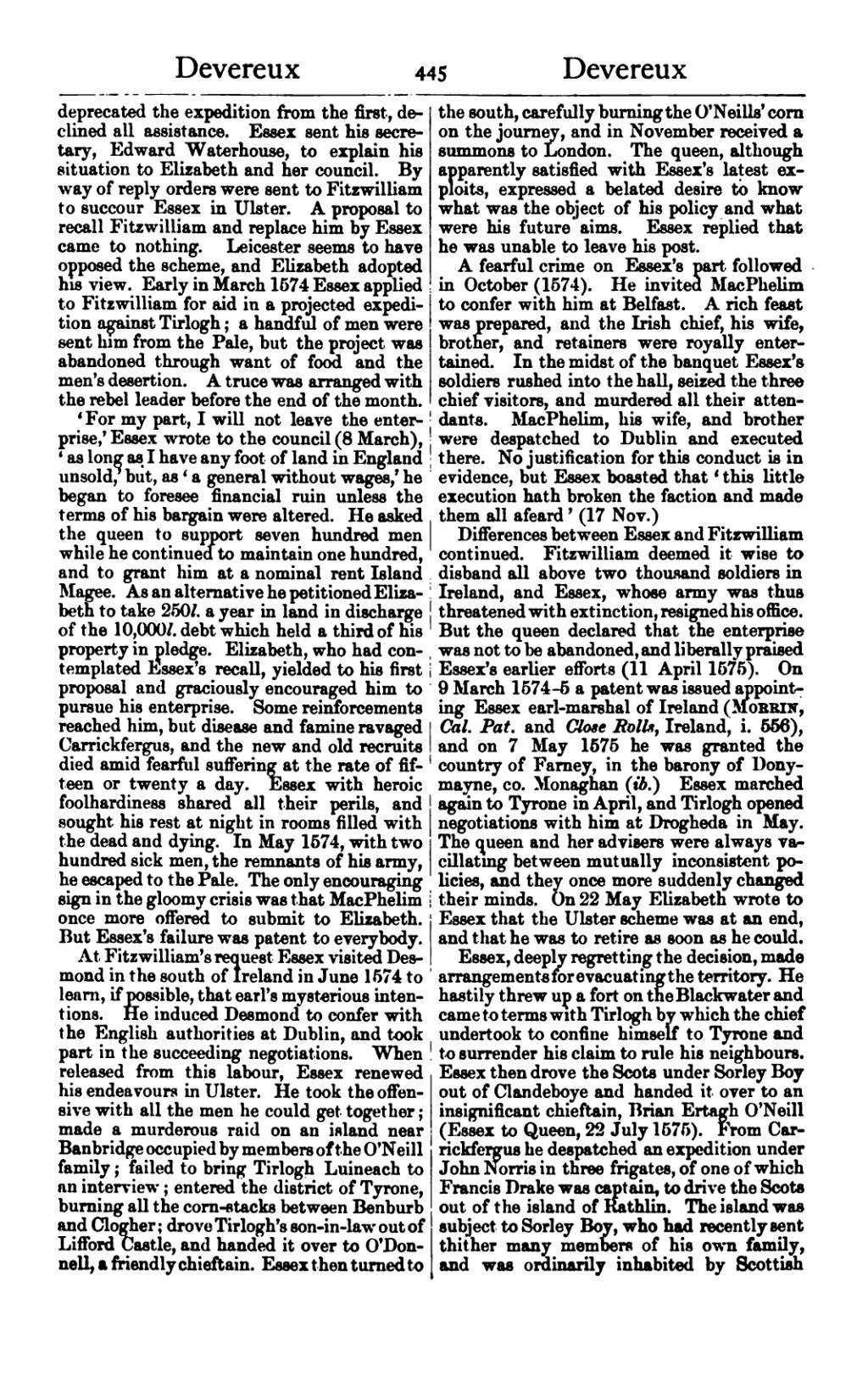deprecated the expedition from the first, declined all assistance. Essex sent his secretary, Edward Waterhouse, to explain his situation to Elizabeth and her council. By way of reply orders were sent to Fitzwilliam to succour Essex in Ulster. A proposal to recall Fitzwilliam and replace him by Essex came to nothing. Leicester seems to have opposed the scheme, and Elizabeth adopted his view. Early in March 1574 Essex applied to Fitzwilliam for aid in a projected expedition against Tirlogh; a handful of men were sent him from the Pale, but the project was abandoned through want of food and the men's desertion. A truce was arranged with the rebel leader before the end of the month.
‘For my part, I will not leave the enterprise,’ Essex wrote to the council (8 March), ‘as long as I have any foot of land in England unsold,’ but, as ‘a general without wages,’ he began to foresee financial ruin unless the terms of his bargain were altered. He asked the queen to support seven hundred men while he continued to maintain one hundred, and to grant him at a nominal rent Island Magee. As an alternative he petitioned Elizabeth to take 250l. a year in land in discharge of the 10,000l. debt which held a third of his property in pledge. Elizabeth, who had contemplated Essex's recall, yielded to his first proposal and graciously encouraged him to pursue his enterprise. Some reinforcements reached him, but disease and famine ravaged Carrickfergus, and the new and old recruits died amid fearful suffering at the rate of fifteen or twenty a day. Essex with heroic foolhardiness shared all their perils, and sought his rest at night in rooms filled with the dead and dying. In May 1574, with two hundred sick men, the remnants of his army, he escaped to the Pale. The only encouraging sign in the gloomy crisis was that MacPhelim once more offered to submit to Elizabeth. But Essex's failure was patent to everybody.
At Fitzwilliam's request Essex visited Desmond in the south of Ireland in June 1574 to learn, if possible, that earl's mysterious intentions. He induced Desmond to confer with the English authorities at Dublin, and took part in the succeeding negotiations. When released from this labour, Essex renewed his endeavours in Ulster. He took the offensive with all the men he could get together; made a murderous raid on an island near Banbridge occupied by members of the O'Neill family; failed to bring Tirlogh Luineach to an interview; entered the district of Tyrone, burning all the corn-stacks between Benburb and Clogher; drove Tirlogh's son-in-law out of Lifford Castle, and handed it over to O'Donnell, a friendly chieftain. Essex then turned to the south, carefully burning the O'Neills' corn on the journey, and in November received a summons to London. The queen, although apparently satisfied with Essex's latest exploits, expressed a belated desire to know what was the object of his policy and what were his future aims. Essex replied that he was unable to leave his post.
A fearful crime on Essex's part followed in October (1574). He invited MacPhelim to confer with him at Belfast. A rich feast was prepared, and the Irish chief, his wife, brother, and retainers were royally entertained. In the midst of the banquet Essex's soldiers rushed into the hall, seized the three chief visitors, and murdered all their attendants. MacPhelim, his wife, and brother were despatched to Dublin and executed there. No justification for this conduct is in evidence, but Essex boasted that ‘this little execution hath broken the faction and made them all afeard’ (17 Nov.).
Differences between Essex and Fitzwilliam continued. Fitzwilliam deemed it wise to disband all above two thousand soldiers in Ireland, and Essex, whose army was thus threatened with extinction, resigned his office. But the queen declared that the enterprise was not to be abandoned, and liberally praised Essex's earlier efforts (11 April 1575). On 9 March 1574–5 a patent was issued appointing Essex earl-marshal of Ireland (Morrin, Cal. Pat. and Close Rolls, Ireland, i. 556), and on 7 May 1575 he was granted the country of Farney, in the barony of Donymayne, co. Monaghan (ib.) Essex marched again to Tyrone in April, and Tirlogh opened negotiations with him at Drogheda in May. The queen and her advisers were always vacillating between mutually inconsistent policies, and they once more suddenly changed their minds. On 22 May Elizabeth wrote to Essex that the Ulster scheme was at an end, and that he was to retire as soon as he could.
Essex, deeply regretting the decision, made arrangements for evacuating the territory. He hastily threw up a fort on the Blackwater and came to terms with Tirlogh by which the chief undertook to confine himself to Tyrone and to surrender his claim to rule his neighbours. Essex then drove the Scots under Sorley Boy out of Clandeboye and handed it over to an insignificant chieftain, Brian Ertagh O'Neill (Essex to Queen, 22 July 1575). From Carrickfergus he despatched an expedition under John Norris in three frigates, of one of which Francis Drake was captain, to drive the Scots out of the island of Rathlin. The island was subject to Sorley Boy, who had recently sent thither many members of his own family, and was ordinarily inhabited by Scottish
